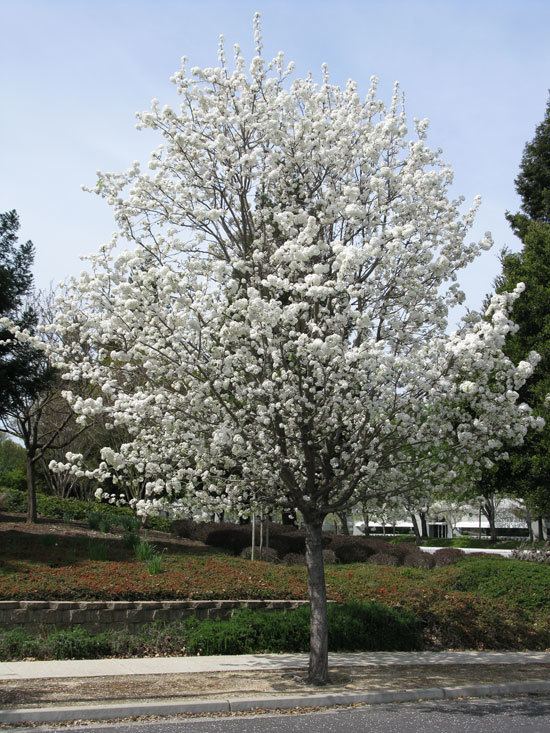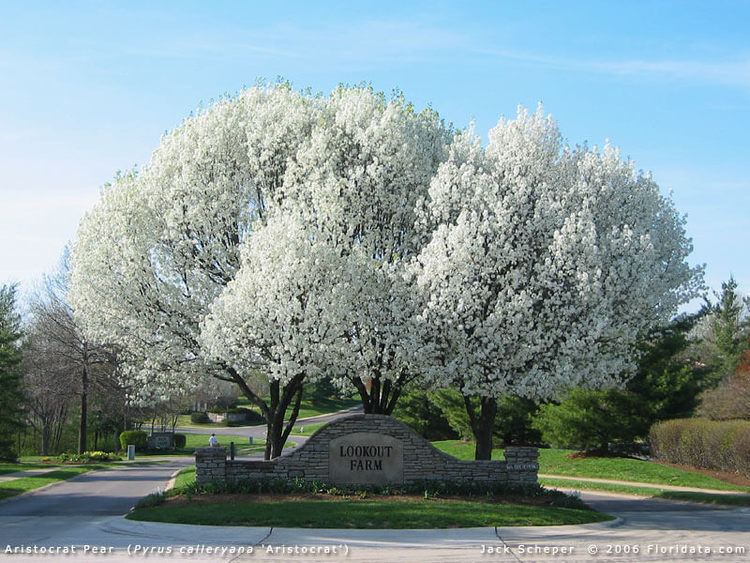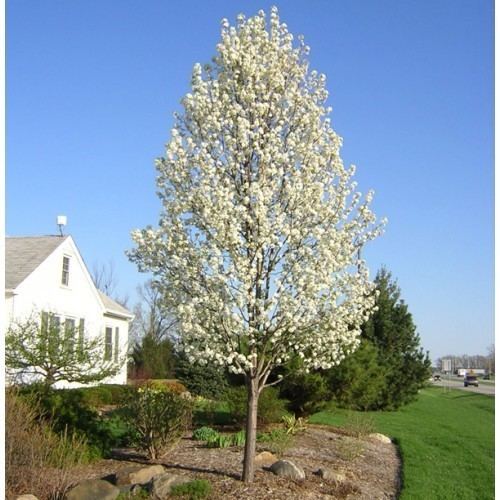Scientific name Pyrus calleryana Rank Species | Genus Pyrus Higher classification Pear | |
 | ||
Similar Pear, Eastern redbud, Pyrus ussuriensis, Pyrus salicifolia, American sweetgum | ||
Bradford pear pyrus calleryana bradford
Pyrus calleryana, the Callery pear, is a species of pear native to China and Vietnam, in the family Rosaceae. It is a deciduous tree growing to 5 to 8 m (16 to 26 ft) tall, often with a conic to rounded crown. The leaves are oval, 4 to 8 cm (1.6 to 3.1 in) long, glossy dark green above, and slightly paler below. The white, five-petaled flowers are about 2 to 2.5 cm (0.79 to 0.98 in) in diameter. They are produced abundantly in early spring, before the leaves expand fully.
Contents
- Bradford pear pyrus calleryana bradford
- Bradford flowering pear pyrus calleryana
- Cultivation
- Uses
- Invasiveness
- Smell
- References

The fruits of the Callery pear are small (less than one cm in diameter), and hard, almost woody, until softened by frost, after which they are readily taken by birds, which disperse the seeds in their droppings. In summer, the foliage is dark green and very smooth, and in autumn the leaves commonly turn brilliant colors, ranging from yellow and orange to more commonly red, pink, purple, and bronze. Sometimes, several of these fall colors may be present on an individual leaf. However, since the color often develops very late in fall, the leaves may be killed by a hard frost before full color can develop.

Callery pears are remarkably resistant to disease or blight though they are regularly killed by strong winds, ice storms, heavy snow, or limb loss due to their naturally excessive growth rates. Some cultivars, such as 'Bradford', are particularly susceptible to storm damage.

The species is named after the Italian-French sinologue Joseph-Marie Callery (1810–1862) who sent specimens of the tree to Europe from China.

Bradford flowering pear pyrus calleryana
Cultivation

In much of North America, cultivars of P. calleryana are so widely planted as ornamental trees that they have become a nuisance. The trees are tolerant of a variety of soil types, drainage levels, and soil acidity. Their crown shape varies from ovate to elliptical, at least until loss of limbs due to excessive and unstable growth rates. The initial symmetry of several cultivars leads to their attempted use in settings such as industrial parks, streets, shopping centers, and office parks. Their dense clusters of white blossoms are conspicuous in early spring, though their smell is commonly found unpleasant by many people. At the latitude of Pittsburgh, Pennsylvania, the trees often remain green until mid-November, and in warm autumns, the colors are often bright, although in a cold year they may get frozen off before coloring. In the South, Callery pears tend to be among the more reliable coloring trees.
Several cultivars of Callery pear are offered commercially, including 'Aristocrat', 'Autumn Blaze', 'Bradford' (the commonly planted '"Bradford pear"), 'Capital', 'Chanticleer' (also known as 'Cleveland Select'), 'New Bradford', 'Redspire', and 'Whitehouse'.
The initially neat, dense upward growth of 'Bradford'—which made it desirable in cramped urban spaces—also results in a multitude of narrow, weak forks, unless corrected by selective pruning at an early stage. These weak crotches make the tree very susceptible to storm damage. Because of this, and the resulting relatively short life span (typically less than 25 years), many groups have discouraged further planting of 'Bradford' and other similarly structurally deficient Callery pear cultivars (such other as 'Cleveland Select') in favor of increasing use of locally native ornamental tree species.
Uses
Pear wood (of any species) is among the finest-textured of all fruitwoods. It is prized for making woodwind instruments, and pear veneer is used in fine furniture. Pear wood also is one of the woods preferred for preparing woodcuts for printing, whether by the end-grained technique for small works, or side-grained for larger works.
Callery pear has been used as rootstock for grafting such pear cultivars as Comice, Bosc, or Seckel, and especially for nashi pear. Pyrus calleryana was first introduced into the United States (in 1909 and 1916) for agricultural experimentation, pre-dating the recognition of the potential value appreciation of the species as an ornamental plant in the 1950s.
Invasiveness
The Callery pear is an invasive species in many areas of eastern North America, outcompeting many native plants and trees. In the northeastern United States, wild Callery pears sometimes form extensive, nearly pure stands in old fields, along roadsides, and in similar disturbed areas.
While various cultivars of the Callery pear are commonly planted for their ornamental value, their prolifically produced fruits are taken by birds, which disperse the seeds in their droppings. The various cultivars are generally themselves self-incompatible, unable to produce fertile seeds when self-pollinated, or cross-pollinated with another tree of the same cultivar. However, if different cultivars of Callery pears are grown in proximity (within insect-pollination distance, about 300 ft or 100 m), they often produce fertile seeds that can sprout and establish wherever they are dispersed. This technique was successfully used in the Dana Gould Gardens near Los Angeles. The resulting wild individuals, of various genetic backgrounds, can in turn interbreed, producing more viable seed and furthering expansion and dispersal of the wild stand of the species. These plants often differ from the selected cultivars in their irregular crown shape and (sometimes) presence of thorns.
Callery pear is reported as established outside cultivation in 152 counties in 25 states in the United States. While these wild plants are sometimes called "Bradford pear" (for the 'Bradford' cultivar), they are actually wild-growing descendants of multiple genotypes of Pyrus calleryana, and hence more correctly referred to by the common (or scientific) name of the species itself.
Smell
The tree is known for its pungent, often unpleasant smell during its flowering stage, which has been described as reminiscent of rotting fish, chlorine, or semen.
